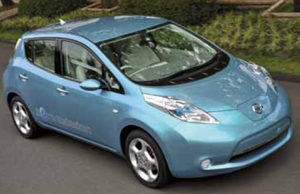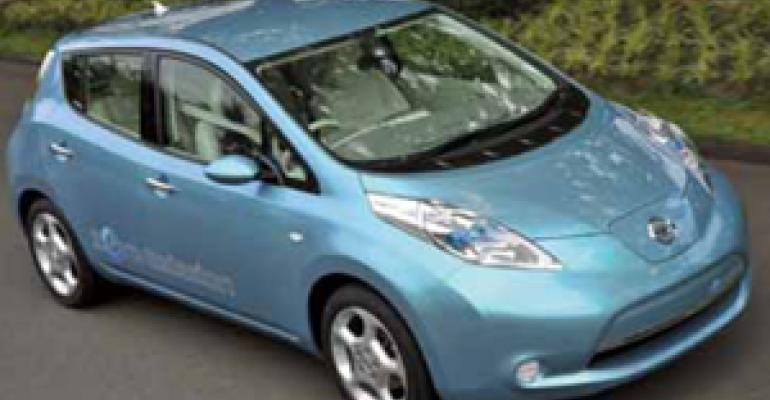
FARMINGTON HILLS, MI – While U.S. sales of electric vehicles have been minuscule so far, concerns remain over the nation’s power grid should demand escalate.
To find the system’s breaking point, Nissan is partnering with General Electric, whose equipment generates or distributes 25% of the world’s electricity. Their 2-year research program also will explore whether EVs could better connect with renewable energy sources and provide residential backup power during a blackout.
“We don’t know where this space is going, what the adoption rate is going to be (or) how it’s going to impact grids, but we want to learn,” Mark Little, senior vice president and director-GE Global Research, tells media today at Nissan’s Detroit-area technical center here.
The partners already have begun specific research projects, with Nissan engineers developing ways to enable an EV to act as a source of energy for a home. Chrysler launched a similar investigation earlier this year using plug-in hybrid Ram pickups.
The companies also are working to incorporate the Leaf EV into GE’s Smart Home project, in which residential energy use is monitored so occupants can better manage its flow and minimize electricity costs.
Another project has researchers from Nissan and GE employing aggregate usage data to simulate the impact millions of EVs would have on electric-power distribution.
GE says it will conduct most of its research at its Niskayuna, NY, lab. Nissan’s tech center here, which primarily serves as the engineering headquarters for light trucks sold in the Americas, will lead the auto maker’s efforts, with support from its Japan-based Advanced Technology Center.
Two years is the optimal partnership time necessary to answer the aforementioned EV-house and EV-grid impact questions, say both Little and Bob Sump, vice president-Nissan Technical Center North America, though neither rules out extending the tie-up.

Additional collaboration is not outlined in the deal, but one day could include using GE’s sodium-based batteries in concert with the Leaf’s lithium-ion batteries.
The sodium-based batteries, devised by GE to store the massive energy generated from hybrid locomotive brakes, could not be used as a sole power source for EVs because they freeze if not kept at a high temperature.
“It’s molten salt, basically, (and) that’s not something you’d want to put in your garage and let it sit there for a month. You go on vacation, come back and your car won’t start,” Little says. “But if you had a dual-battery system you could use the lithium battery to get it going, heat up the sodium battery and off you go. But that’s a futuristic thing.”
Nissan has sold more than 15,000 Leafs globally since the EV went on sale late last year, with 7,000 delivered to customers in the U.S.
Initial U.S. sales were limited to seven states, but yesterday Nissan began taking orders for ’12 Leafs in Colorado, Connecticut, Massachusetts, New Hampshire, New Jersey and New York. By the end of 2011, the Leaf will be available in 22 states.
Still, the car’s sales pace is below the 50,000-unit capacity of Nissan’s Oppama, Japan, plant where the Leaf is built for all markets.
Sump says Nissan knows that for the Leaf to appeal to more buyers, “you have to have the infrastructure (in place) to do that.” The auto maker believes the GE pact presents opportunities “to make the EV a more practical part” of consumers’ lives.




